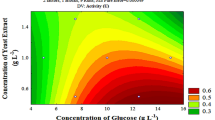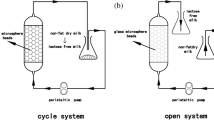Abstract
Eggshell membrane (ESM) is used in immobilization studies due to its large surface area, non-toxicity and biodegradability. In this study, β-galactosidase was immobilized on ESM using the adsorption and cross-linking method. The interactions between enzyme and ESM after immobilization were determined by ATR-FTIR (attenuated total reflection fourier transform infrared spectroscopy) and SEM (scanning electron microscope). The optimum temperature of the free enzyme was found to be 35 °C, and this value was 45 °C for the immobilized enzyme. Immobilized enzyme managed to retain more than 50% of its activity after 8 reuses. In the lactose removal experiment from milk, the highest reaction efficiency was found as 55.8% under specified optimization conditions for β-galactosidase immobilized ESM after 3 h. Due to the microfiber protein structure of the ESM, it has improved enzyme stability properties, as a result of the multi protein–protein interactions formed after the immobilization between the proteins in the ESM and the enzyme molecules.







Similar content being viewed by others
Data availability
Not applicable
Code availability
Not applicable.
References
Adhikari K, Dooley LM, Chambers E IV, Bhumiratana N (2010) Sensory characteristics of commercial lactose-free milks manufactured in the United States. LWT - Food Sci Technol 43:113–118. https://doi.org/10.1016/j.lwt.2009.06.017
Benavente R, Pessela BC, Curiel JA et al (2015) Improving properties of a novel β-galactosidase from Lactobacillus plantarum by covalent immobilization. Molecules 20:7874–7889. https://doi.org/10.3390/molecules20057874
Panesar R, Panesar PS, Singh RS, Kennedy JF (2011) Hydrolysis of milk lactose in a packed bed reactor system using immobilized yeast cells. J Chem Technol Biotechnol 86:42–46. https://doi.org/10.1002/jctb.2481
Ricardi NC, de Menezes EW, Valmir Benvenutti E et al (2018) Highly stable novel silica/chitosan support for β-galactosidase immobilization for application in dairy technology. Food Chem 246:343–350. https://doi.org/10.1016/j.foodchem.2017.11.026
Husain Q, Ansari SA, Alam F, Azam A (2011) Immobilization of Aspergillus oryzae β galactosidase on zinc oxide nanoparticles via simple adsorption mechanism. Int J Biol Macromol 49:37–43. https://doi.org/10.1016/j.ijbiomac.2011.03.011
Labus K (2018) Effective detection of biocatalysts with specified activity by using a hydrogel-based colourimetric assay - β-galactosidase case study. PLoS ONE 13:1–11. https://doi.org/10.1371/journal.pone.0205532
Numanoǧlu Y, Sungur S (2004) β-galactosidase from Kluyveromyces lactis cell disruption and enzyme immobilization using a cellulose-gelatin carrier system. Process Biochem 39:705–711. https://doi.org/10.1016/S0032-9592(03)00183-3
Klein MP, Fallavena LP, Schöffer JDN et al (2013) High stability of immobilized β-d-galactosidase for lactose hydrolysis and galactooligosaccharides synthesis. Carbohydr Polym 95:465–470. https://doi.org/10.1016/j.carbpol.2013.02.044
Liu W, Wang L, Jiang R (2012) Specific enzyme immobilization approaches and their application with nanomaterials. Top Catal 55:1146–1156. https://doi.org/10.1007/s11244-012-9893-0
Wang ZG, Wan LS, Liu ZM et al (2009) Enzyme immobilization on electrospun polymer nanofibers: an overview. J Mol Catal B Enzym 56:189–195. https://doi.org/10.1016/j.molcatb.2008.05.005
Boltachev GS, Nagayev KA, Paranin SN, et al (2011) Theory of the magnetic pulsed compaction of nanosized powders. Nanomater Prop Prep Process 1–58.
Brena B, González-Pombo P, Batista-Viera F (2013) Immobilization of enzymes and cells. Immobil Enzym Cells Third Ed Methods Mol Biol 1051:15–31. https://doi.org/10.1007/978-1-62703-550-7
Işik C, Arabaci G, Ispirli Doğaç Y et al (2019) Synthesis and characterization of electrospun PVA/Zn2+ metal composite nanofibers for lipase immobilization with effective thermal pH stabilities and reusability. Mater Sci Eng C. https://doi.org/10.1016/j.msec.2019.02.031
Haghju S, Bari MR, Khaled-Abad MA (2018) Affecting parameters on fabrication of β-D-galactosidase immobilized chitosan/poly (vinyl alcohol) electrospun nanofibers. Carbohydr Polym 200:137–143. https://doi.org/10.1016/j.carbpol.2018.07.096
Kessi E, Arias JL (2019) Using natural waste material as a matrix for the immobilization of enzymes: chicken eggshell membrane powder for β-galactosidase immobilization. Appl Biochem Biotechnol 187:101–115. https://doi.org/10.1007/s12010-018-2805-4
Klein MP, Hackenhaar CR, Lorenzoni ASG et al (2016) Chitosan crosslinked with genipin as support matrix for application in food process: Support characterization and β-d-galactosidase immobilization. Carbohydr Polym 137:184–190. https://doi.org/10.1016/j.carbpol.2015.10.069
Pan C, Hu B, Li W et al (2009) Novel and efficient method for immobilization and stabilization of β-d-galactosidase by covalent attachment onto magnetic Fe3O4-chitosan nanoparticles. J Mol Catal B Enzym 61:208–215. https://doi.org/10.1016/j.molcatb.2009.07.003
Verma ML, Barrow CJ, Kennedy JF, Puri M (2012) Immobilization of β-d-galactosidase from Kluyveromyces lactis on functionalized silicon dioxide nanoparticles: characterization and lactose hydrolysis. Int J Biol Macromol 50:432–437. https://doi.org/10.1016/j.ijbiomac.2011.12.029
Wahba MI (2016) Treated calcium pectinate beads for the covalent immobilization of β-D-galactosidase. Int J Biol Macromol 91:877–886. https://doi.org/10.1016/j.ijbiomac.2016.06.044
Wolf M, Gasparin BC, Paulino AT (2018) Hydrolysis of lactose using β-D-galactosidase immobilized in a modified Arabic gum-based hydrogel for the production of lactose-free/low-lactose milk. Int J Biol Macromol 115:157–164. https://doi.org/10.1016/j.ijbiomac.2018.04.058
Hernandez K, Fernandez-Lafuente R (2011) Control of protein immobilization: coupling immobilization and site-directed mutagenesis to improve biocatalyst or biosensor performance. Enzyme Microb Technol 48:107–122. https://doi.org/10.1016/j.enzmictec.2010.10.003
Rueda N, dos Santos JCS, Ortiz C et al (2016) Chemical modification in the design of immobilized enzyme biocatalysts: drawbacks and opportunities. Chem Rec 16:1436–1455. https://doi.org/10.1002/tcr.201600007
Bedade DK, Sutar YB, Singhal RS (2019) Chitosan coated calcium alginate beads for covalent immobilization of acrylamidase: process parameters and removal of acrylamide from coffee. Food Chem 275:95–104. https://doi.org/10.1016/j.foodchem.2018.09.090
de Lima JS, Cabrera MP, Casazza AA et al (2018) Immobilization of Aspergillus ficuum tannase in calcium alginate beads and its application in the treatment of boldo (Peumus boldus) tea. Int J Biol Macromol 118:1989–1994. https://doi.org/10.1016/j.ijbiomac.2018.07.084
Sondhi S, Kaur R, Kaur S, Kaur PS (2018) Immobilization of laccase-ABTS system for the development of a continuous flow packed bed bioreactor for decolorization of textile effluent. Int J Biol Macromol 117:1093–1100. https://doi.org/10.1016/j.ijbiomac.2018.06.007
Chattopadhyay S, Sen R (2012) A comparative performance evaluation of jute and eggshell matrices to immobilize pancreatic lipase. Process Biochem 47:749–757. https://doi.org/10.1016/j.procbio.2012.02.003
Jiang C, Cheng C, Hao M et al (2017) Enhanced catalytic stability of lipase immobilized on oxidized and disulfide-rich eggshell membrane for esters hydrolysis and transesterification. Int J Biol Macromol 105:1328–1336. https://doi.org/10.1016/j.ijbiomac.2017.07.166
Du L, Huang M, Feng JX (2017) Immobilization of α-amylase on eggshell membrane and Ag-nanoparticle-decorated eggshell membrane for the biotransformation of starch. Starch/Staerke 69:1–7. https://doi.org/10.1002/star.201600352
Al-Ghouti MA, Khan M (2018) Eggshell membrane as a novel bio sorbent for remediation of boron from desalinated water. J Environ Manage 207:405–416. https://doi.org/10.1016/j.jenvman.2017.11.062
Cordeiro CMM, Hincke MT (2015) Quantitative proteomics analysis of eggshell membrane proteins during chick embryonic development. J Proteomics 130:11–25. https://doi.org/10.1016/j.jprot.2015.08.014
Du J, Hincke MT, Rose-Martel M et al (2015) Identifying specific proteins involved in eggshell membrane formation using gene expression analysis and bioinformatics. BMC Genomics 16:1–14. https://doi.org/10.1186/s12864-015-2013-3
Rao A, Arias JL, Cölfen H (2017) On mineral retrosynthesis of a complex biogenic scaffold. Inorganics 5:16. https://doi.org/10.3390/inorganics5010016
Baláž M (2014) Eggshell membrane biomaterial as a platform for applications in materials science. Acta Biomater 10:3827–3843. https://doi.org/10.1016/j.actbio.2014.03.020
Park S, Choi KS, Lee D et al (2016) Eggshell membrane: review and impact on engineering. Biosyst Eng 151:446–463. https://doi.org/10.1016/j.biosystemseng.2016.10.014
Bahl OP, Agrawal KML (1969) Glycosidases of Aspergillus niger. J Biol Chem 244:2970–2978. https://doi.org/10.1016/S0021-9258(18)91719-9
Bradford MM (1976) A rapid and sensitive method for the quantitation of microgram quantities of protein utilizing the principle of protein-dye binding. Anal Biochem 72:248–254
Işık C, Saraç N, Teke M, Uğur A (2021) A new bioremediation method for removal of wastewater containing oils with high oleic acid composition: Acinetobacter haemolyticuslipase immobilized on eggshell membrane with improved stabilities. New J Chem 45:1984–1992. https://doi.org/10.1039/D0NJ05175F
Pundir CS, Chauhan NS, Bhambi M (2008) Activation of polyvinyl chloride sheet surface for covalent immobilization of oxalate oxidase and its evaluation as inert support in urinary oxalate determination. Anal Biochem 374:272–277. https://doi.org/10.1016/j.ab.2007.11.008
Bayramoglu G, Tunali Y, Arica MY (2007) Immobilization of β-galactosidase onto magnetic poly(GMA-MMA) beads for hydrolysis of lactose in bed reactor. Catal Commun 8:1094–1101. https://doi.org/10.1016/j.catcom.2006.10.029
Zhang S, Gao S, Gao G (2010) Immobilization of β-galactosidase onto magnetic beads. Appl Biochem Biotechnol 160:1386–1393. https://doi.org/10.1007/s12010-009-8600-5
Zhang Z, Zhang R, Chen L, McClements DJ (2016) Encapsulation of lactase (β-galactosidase) into κ-carrageenan-based hydrogel beads: Impact of environmental conditions on enzyme activity. Food Chem 200:69–75. https://doi.org/10.1016/j.foodchem.2016.01.014
Das B, Roy AP, Bhattacharjee S et al (2015) Lactose hydrolysis by β-galactosidase enzyme: optimization using response surface methodology. Ecotoxicol Environ Saf 121:244–252. https://doi.org/10.1016/j.ecoenv.2015.03.024
Estevinho BN, Damas AM, Martins P, Rocha F (2014) Microencapsulation of β-galactosidase with different biopolymers by a spray-drying process. Food Res Int 64:134–140. https://doi.org/10.1016/j.foodres.2014.05.057
Weymuth T, Jacob CR, Reiher M (2010) A local-mode model for understanding the dependence of the extended amide III vibrations on protein secondary structure. J Phys Chem B 114:10649–10660. https://doi.org/10.1021/jp104542w
Acknowledgements
This study is a part of Selen Kızıldağ’s MSc thesis.
Author information
Authors and Affiliations
Contributions
Not applicable.
Corresponding author
Ethics declarations
Conflicts of interest
The authors declare that they have no conflicts of interest.
Ethical approval
Not applicable.
Consent to participate
Not applicable.
Consent for publication
Not applicable.
Additional information
Publisher's Note
Springer Nature remains neutral with regard to jurisdictional claims in published maps and institutional affiliations.
Rights and permissions
Springer Nature or its licensor (e.g. a society or other partner) holds exclusive rights to this article under a publishing agreement with the author(s) or other rightsholder(s); author self-archiving of the accepted manuscript version of this article is solely governed by the terms of such publishing agreement and applicable law.
About this article
Cite this article
Kızıldağ, S., Işık, C. & Teke, M. Milk lactose removal by β-galactosidase immobilized on eggshell membrane. Eur Food Res Technol 249, 2125–2136 (2023). https://doi.org/10.1007/s00217-023-04280-3
Received:
Revised:
Accepted:
Published:
Issue Date:
DOI: https://doi.org/10.1007/s00217-023-04280-3




